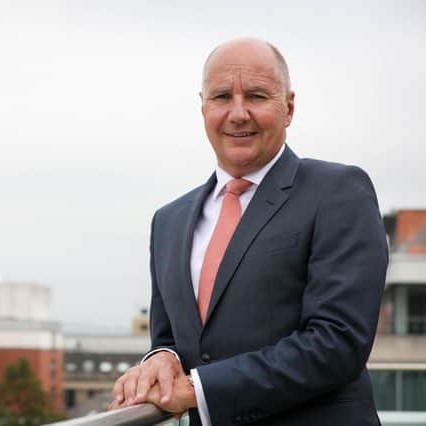Identifying today’s winning GTM strategies
Navigating the channel's competitive landscape with a fit for purpose GTM strategy is a growing priority as competition intensifies, customer expectations shoot up and the market hits saturation point. Here, channel leaders highlight their three biggest go-to-market challenges and how they are addressing them.
BRITT MEGAHEY,
FOUNDER AND MD, BARCLAY COMMUNICATIONS
 For resellers and MSPs, the biggest go-to-market challenge today is differentiation. When everyone is selling the same SIP, UCaaS and broadband, value must come from service, integration and trust, not just price. Second is demand generation. Buyers are smarter and more sceptical. Cold calls and generic pitches don’t work. At Barclay, we’ve learned that clear messaging, real customer outcomes and specialist knowledge make all the difference. Lastly, vendor control can make or break delivery. If your upstream partner drops the ball, your brand takes the hit. The answer? Build strong, transparent relationships and stay close to the customer experience from start to finish. The telecoms space is tough, but for those who adapt, the opportunity remains massive.
For resellers and MSPs, the biggest go-to-market challenge today is differentiation. When everyone is selling the same SIP, UCaaS and broadband, value must come from service, integration and trust, not just price. Second is demand generation. Buyers are smarter and more sceptical. Cold calls and generic pitches don’t work. At Barclay, we’ve learned that clear messaging, real customer outcomes and specialist knowledge make all the difference. Lastly, vendor control can make or break delivery. If your upstream partner drops the ball, your brand takes the hit. The answer? Build strong, transparent relationships and stay close to the customer experience from start to finish. The telecoms space is tough, but for those who adapt, the opportunity remains massive.
IAIN JOHNSON,
HEAD OF SOLUTION DESIGN, FOURNET
 In a saturated market, differentiation is everything. We’ve shifted from being a tech reseller to becoming a trusted advisor, offering consultancy-led, outcome-focused solutions. Second, integration and customisation are becoming more complex. Customers want solutions that work seamlessly with what they’ve got, as well as what they’re planning next. And third, sales cycles are long and often stalled by decision making inertia. To overcome that, we focus on delivering early value, sharing proven CX-led results and showing how we’ve done it for other customers. It’s all about building trust, reducing risk and delivering results, quickly and clearly.
In a saturated market, differentiation is everything. We’ve shifted from being a tech reseller to becoming a trusted advisor, offering consultancy-led, outcome-focused solutions. Second, integration and customisation are becoming more complex. Customers want solutions that work seamlessly with what they’ve got, as well as what they’re planning next. And third, sales cycles are long and often stalled by decision making inertia. To overcome that, we focus on delivering early value, sharing proven CX-led results and showing how we’ve done it for other customers. It’s all about building trust, reducing risk and delivering results, quickly and clearly.
RICHARD SCOTT,
SALES DIRECTOR, START COMMUNICATIONS
 The top challenge is building brand awareness and standing out in a saturated market. It is critical to define a clear identity by targeting specific verticals and aligning with industry-specific platforms like CRMs. This creates relevance, differentiation and added value. The second challenge is managing pricing pressure. Per-user pricing comparisons often lead to commoditisation, squeezing margins and undervaluing services. We are focusing on the quality of our service, technical expertise and responsive customer support, prioritising long-term value over short-term cost. The third challenge is maintaining service excellence as the business scales. Growth can strain support capabilities, increasing the risk of customer churn. To counter this, we invest in proactive monitoring, automation and managed services, ensuring we meet SLAs and deliver a reliable, high-touch experience.
The top challenge is building brand awareness and standing out in a saturated market. It is critical to define a clear identity by targeting specific verticals and aligning with industry-specific platforms like CRMs. This creates relevance, differentiation and added value. The second challenge is managing pricing pressure. Per-user pricing comparisons often lead to commoditisation, squeezing margins and undervaluing services. We are focusing on the quality of our service, technical expertise and responsive customer support, prioritising long-term value over short-term cost. The third challenge is maintaining service excellence as the business scales. Growth can strain support capabilities, increasing the risk of customer churn. To counter this, we invest in proactive monitoring, automation and managed services, ensuring we meet SLAs and deliver a reliable, high-touch experience.
NIKKI LAKER,
MARKETING DIRECTOR, OPUS TECH
 AI is reshaping the marketing landscape across all industries. It can execute to an outstanding level when used effectively, not replacing the human element of marketing but enhancing it. We have spun up tactical campaigns in a matter of hours using Chat GPT Paid to elevate performance. Buying committees are getting larger and more complex. It’s critical to understand who is in the mix and what they need to help shorten the sales process. You will see buyers doing all the research before making inbound enquiries. They already know what they want, so making sure you do it differently or to a higher level is critical. The current economic climate is creating a reluctance to spend, with projects being put on hold. It is important to look for creative ways to nurture these buying committees and keep them alive so when the project reactivates your business will be front of mind.
AI is reshaping the marketing landscape across all industries. It can execute to an outstanding level when used effectively, not replacing the human element of marketing but enhancing it. We have spun up tactical campaigns in a matter of hours using Chat GPT Paid to elevate performance. Buying committees are getting larger and more complex. It’s critical to understand who is in the mix and what they need to help shorten the sales process. You will see buyers doing all the research before making inbound enquiries. They already know what they want, so making sure you do it differently or to a higher level is critical. The current economic climate is creating a reluctance to spend, with projects being put on hold. It is important to look for creative ways to nurture these buying committees and keep them alive so when the project reactivates your business will be front of mind.
JALPA SHARMA,
MD, DBSL
 Margin erosion is a growing issue and competing on price alone is no longer viable. At DBSL, we tackle this by offering bundled solutions with performance-based SLAs that focus on long-term value, not just cost. Second, there’s still a perception gap around offshoring. Some equate it with compromise. We address this through transparent onboarding, reliable infrastructure and real-world case studies that prove otherwise. Finally, the biggest challenge I see is scaling sales without scaling overhead. Most teams simply don’t have the resources. We embed AI and automation into pre-sales, onboarding and support—freeing up internal teams to focus on relationship-building and closing deals.
Margin erosion is a growing issue and competing on price alone is no longer viable. At DBSL, we tackle this by offering bundled solutions with performance-based SLAs that focus on long-term value, not just cost. Second, there’s still a perception gap around offshoring. Some equate it with compromise. We address this through transparent onboarding, reliable infrastructure and real-world case studies that prove otherwise. Finally, the biggest challenge I see is scaling sales without scaling overhead. Most teams simply don’t have the resources. We embed AI and automation into pre-sales, onboarding and support—freeing up internal teams to focus on relationship-building and closing deals.
JULIE BISHOP,
CEO, IT NATURALLY
 The go-to-market landscape is shifting and IT Naturally is adapting. Firstly, flexible co-managed models because not every business wants to fully outsource. Many have in-house IT teams they value but they need trusted support out-of-hours. So we are becoming an extension of their team on evenings and weekends. Our hybrid approach ensures continuity without disruption. Then there's the short-term mindset. Long-term contracts are ideal, but not always realistic in today’s climate. We offer flexible contract lengths and rework onboarding models to ensure our services remain accessible. It’s about meeting customers where they are, not just where we’d like them to be. Next, cybersecurity: There are still many companies that don’t have basic cybersecurity in place. We carry out audits to assess risk, then co-create a roadmap prioritised by urgency and budget. This means customers feel in control and secure at a pace that suits their business.
The go-to-market landscape is shifting and IT Naturally is adapting. Firstly, flexible co-managed models because not every business wants to fully outsource. Many have in-house IT teams they value but they need trusted support out-of-hours. So we are becoming an extension of their team on evenings and weekends. Our hybrid approach ensures continuity without disruption. Then there's the short-term mindset. Long-term contracts are ideal, but not always realistic in today’s climate. We offer flexible contract lengths and rework onboarding models to ensure our services remain accessible. It’s about meeting customers where they are, not just where we’d like them to be. Next, cybersecurity: There are still many companies that don’t have basic cybersecurity in place. We carry out audits to assess risk, then co-create a roadmap prioritised by urgency and budget. This means customers feel in control and secure at a pace that suits their business.
PETE TOMLINSON,
CEO, WINDSOR TELECOM
 It’s tough for many SMEs right now. They want to deliver a brilliant customer and employee experience while reducing costs. That means being guided in how to succeed, not sold-point solutions. We’ve created propositions that meet specific business challenges and communicate them in a way that’s easy to consume. Organisations increasingly want a single provider with vision and strategy, but many providers lack these qualities, prompting them to switch. We’ve curated a broad portfolio of providers into a single tailored service model. The automation and AI imperative has now arrived. Creating a portfolio of services with these tools embedded allows for easy adoption. We’re also investing in developing our team so they can work side by side with customers to help prepare them to securely adopt these new ways of working.
It’s tough for many SMEs right now. They want to deliver a brilliant customer and employee experience while reducing costs. That means being guided in how to succeed, not sold-point solutions. We’ve created propositions that meet specific business challenges and communicate them in a way that’s easy to consume. Organisations increasingly want a single provider with vision and strategy, but many providers lack these qualities, prompting them to switch. We’ve curated a broad portfolio of providers into a single tailored service model. The automation and AI imperative has now arrived. Creating a portfolio of services with these tools embedded allows for easy adoption. We’re also investing in developing our team so they can work side by side with customers to help prepare them to securely adopt these new ways of working.
JAMES ROUTLEDGE,
CHIEF SALES OFFICER, GLOBAL4
 In a saturated market, traditional means of winning fresh business at scale are tougher and more costly than ever. For us, business through recommendation or embedding into a sector with partnerships has a far greater impact than telemarketing, PPC or emailing alone. Also, many businesses look at IT support, telephony, connectivity and cybersecurity etc as commoditised products. The truth is that choosing the MSP desperate enough to provide it at near loss-making numbers poses a significant risk – and supporting a change in client mindset on this can be challenging. Thirdly, it’s easy to say yes to all client demands and stretch yourself too thin. We must have an eye on how we best support the client on an ongoing basis and educate change, or in other cases simply qualify out of a deal.
In a saturated market, traditional means of winning fresh business at scale are tougher and more costly than ever. For us, business through recommendation or embedding into a sector with partnerships has a far greater impact than telemarketing, PPC or emailing alone. Also, many businesses look at IT support, telephony, connectivity and cybersecurity etc as commoditised products. The truth is that choosing the MSP desperate enough to provide it at near loss-making numbers poses a significant risk – and supporting a change in client mindset on this can be challenging. Thirdly, it’s easy to say yes to all client demands and stretch yourself too thin. We must have an eye on how we best support the client on an ongoing basis and educate change, or in other cases simply qualify out of a deal.
MARK SALVIN,
CEO, ORBITAL10
 The biggest GTM challenge in cybersecurity is getting clients to recognise their own vulnerabilities and take them seriously. Many believe they’re too small to be targeted or that their current setup is good enough. When things go wrong, it’s not just inconvenient, it’s costly, disruptive and damaging to trust. Clients need to understand that proactive investment in security and support is essential. Prevention is always more cost-effective than recovery. The second challenge is standing out in a saturated market. Too many MSPs offer surface-level fixes that leave businesses exposed. What clients really need is a strategic partner who understands their risks and delivers tailored, outcome-driven solutions. Finally, even when clients are ready to act, complexity often holds them back. That’s why it’s crucial to simplify the process, guiding them with clarity so they can make confident decisions.
The biggest GTM challenge in cybersecurity is getting clients to recognise their own vulnerabilities and take them seriously. Many believe they’re too small to be targeted or that their current setup is good enough. When things go wrong, it’s not just inconvenient, it’s costly, disruptive and damaging to trust. Clients need to understand that proactive investment in security and support is essential. Prevention is always more cost-effective than recovery. The second challenge is standing out in a saturated market. Too many MSPs offer surface-level fixes that leave businesses exposed. What clients really need is a strategic partner who understands their risks and delivers tailored, outcome-driven solutions. Finally, even when clients are ready to act, complexity often holds them back. That’s why it’s crucial to simplify the process, guiding them with clarity so they can make confident decisions.
